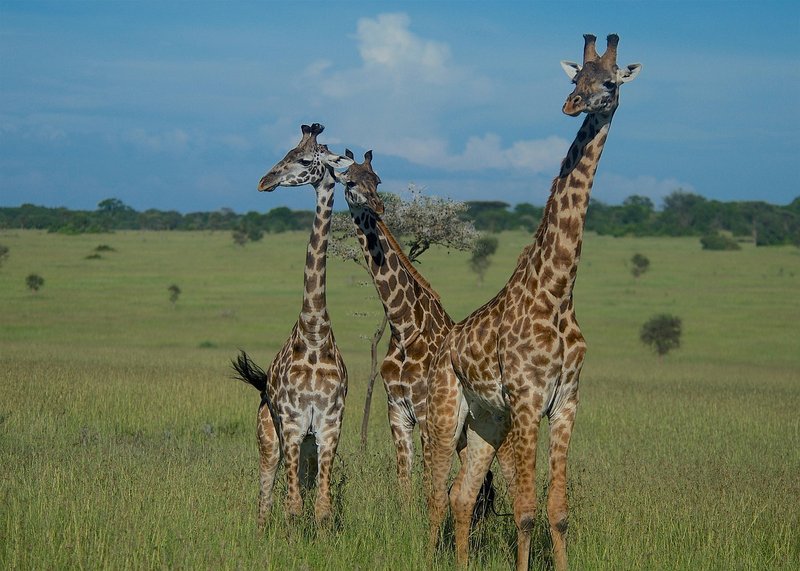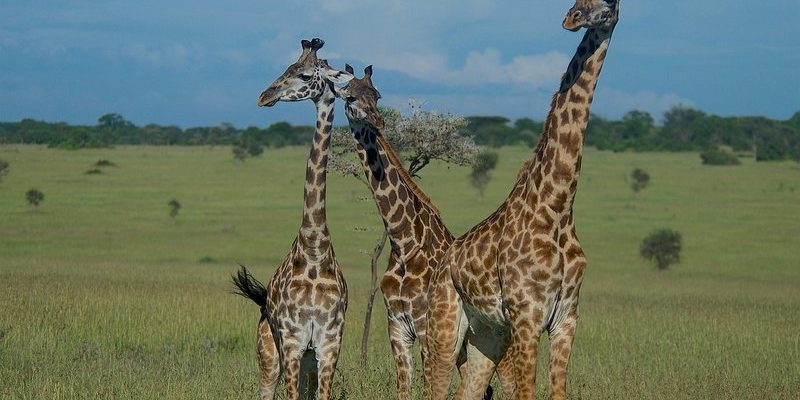
When you think about the African savanna, one animal likely springs to mind: the giraffe. With their long necks and unique spotted coats, these gentle giants are some of the most recognizable creatures on the planet. They stand tall—literally—topping out at heights of up to 18 feet! Imagine being able to reach the highest branches of trees with ease. That’s one of the many amazing adaptations that enables giraffes to thrive in their environments.
Giraffes are not just tall; they’re also fascinating animals with a complex social structure and surprisingly gentle temperament. They spend most of their time grazing on leaves and buds from trees, primarily acacias. While they might seem like slow-moving creatures, giraffes can actually run surprisingly fast when they need to, reaching speeds of up to 37 miles per hour. But there’s much more to explore about these incredible animals.
Here’s the thing: understanding giraffes goes beyond just their height and diet. Their unique behaviors, habitats, and interactions with other species are vital parts of what makes them such captivating wildlife. So, let’s dive deeper into the world of giraffes and discover what makes them truly special.
Physical Characteristics
Giraffes are known for their distinctive height, but there’s much more to their physical characteristics that makes them unique. Their long necks are made up of just seven vertebrae, the same number that humans have. Each of these vertebrae is elongated, allowing them to reach high branches for feeding, but also creating elegant, towering silhouettes against the skyline.
Another striking feature is their pattern of spots, which can vary significantly from one giraffe to another. These spots aren’t just for show; they serve a purpose. The patterns help with camouflage, breaking up their silhouette in the dappled light of the trees, making it harder for predators to spot them. The color of these spots can also reflect the giraffe’s health and age, allowing other giraffes to gauge the fitness of potential mates.
Additionally, giraffes have long legs—each leg can be around six feet in length! This height isn’t just for reaching trees; it also helps them see farther across the plains, making it easier to spot danger. Giraffes also have specialized tongues that are around 20 inches long, which are prehensile and help them grasp leaves and twigs. Their tongues are also darkly pigmented, which protects them from sunburn while they browse in the sun.
Habitat of Giraffes
Giraffes primarily inhabit the savanna and open woodlands of Africa. They’re found in a range of countries from South Africa to Niger and across to Kenya. Their favorite spots are areas where acacia and mimosa trees are abundant, as these provide their favorite types of food. These tall trees not only give giraffes access to tasty leaves but also serve as a backdrop to their unique lifestyle.
You might wonder how giraffes adapt to their environment. They are well-suited to the dry savanna climate, where they can go long periods without drinking water. Instead, they obtain most of their moisture through the plants they eat, which is a clever way to survive in arid regions. However, when they do drink, they have to spread their legs wide apart or bend down to get low enough to the water source—which can be quite a comical sight!
Unfortunately, giraffes are losing their habitat due to human encroachment, agriculture, and urban development. Conservation efforts are critical to ensuring that these extraordinary animals can thrive in the wild for generations to come. By protecting their natural habitats, we also help maintain the balance of many ecosystems.
Diet and Feeding Habits
When it comes to food, giraffes are herbivores with a diet that consists mainly of leaves, fruits, and flowers from trees and shrubs. Acacia trees are a particular favorite due to their nutritious leaves. Giraffes spend a significant amount of their day—up to 20 hours—eating to meet their energy needs. Their long necks and specialized lips allow them to reach leaves that other herbivores can’t, giving them a competitive edge in their natural habitat.
One interesting aspect of giraffe feeding habits is their method of eating. They use their prehensile tongues to grasp foliage and pull it into their mouths. Their tongues are amazing—thick and muscular, they can easily handle thorny leaves, and they even have a grasping motion to get those tricky leaves off branches. Plus, the dark color of their tongues helps prevent sunburn!
You might be surprised to learn that giraffes also practice something called “selective feeding.” This means they carefully choose the most nutritious leaves. They might avoid certain areas after heavy browsing to allow those trees a chance to recover. This behavior shows just how intelligent and aware these animals are about their surroundings. They aren’t just mindlessly munching away; they’re actively considering the health of their ecosystem.
Social Behavior
Giraffes are typically social animals, often seen in loose herds of 10 to 20 individuals. These herds can change frequently, as giraffes often mix with different groups. Within these social structures, females and their young tend to remain closer together, while males may drift into bachelor groups. Males occasionally engage in necking, which is a behavior where they swing their necks and heads to spar with each other. This isn’t just about dominance; it’s also a way to establish social rankings among males.
Interestingly, giraffe social behavior isn’t just limited to physical interactions. They have been observed using vocalizations, body language, and even social grooming to bond with one another. The gentle interactions between giraffes, such as rubbing their necks and bodies against each other, help strengthen social ties. This shows that they have emotional connections and can form friendships, much like humans do.
Even more fascinating is how mother giraffes care for their calves. Calves are usually born after a long gestation period of about 15 months, and when they are born, they can stand and walk within a few hours. Mothers are very protective, keeping their young close and carefully watching for predators. This nurturing behavior reflects the strong maternal instincts that giraffes possess, ensuring their young have the best chance of survival.
Conservation Status
As majestic as giraffes are, they face some serious threats. Currently, giraffes are listed as vulnerable, with populations declining due to habitat loss, poaching, and human-wildlife conflict. In the past few decades, giraffe numbers have decreased by about 40%. That’s a staggering statistic that highlights the urgency of conservation efforts.
Conservation organizations are working hard to protect giraffe habitats and fight against illegal poaching. Community-based tourism and education programs are essential components of these efforts. When local communities see the value of preserving giraffes and their habitats, they become more invested in protecting them.
One heartening aspect is that there are multiple conservation programs aimed specifically at giraffe species. Different subspecies have unique needs and threats, and tailored conservation efforts can make a significant impact. For instance, the Rothschild’s giraffe is particularly endangered, and targeted efforts are underway to increase its population numbers. Every little bit helps in the fight to protect these gentle giants.
Interesting Facts About Giraffes
| Height: | Up to 18 feet (5.5 meters) |
| Weight: | 1,600 to 3,000 pounds (725 to 1,360 kg) |
| Diet: | Herbivore; primarily acacia leaves |
| Lifespan: | 25 years in the wild; up to 30 years in captivity |
| Speed: | Up to 37 miles per hour (60 km/h) |
| Social Structure: | Loose herds of 10–20 individuals |
| Calf Height at Birth: | Approximately 6 feet (1.8 meters) |
FAQ
What are the main threats facing giraffes today?
The primary threats to giraffes include habitat loss due to agriculture and urban development, poaching for their skins and bones, and human-wildlife conflict. As human populations expand into traditional giraffe habitats, there’s simply less room for them to roam and feed. Conservation efforts aim to tackle these issues by protecting habitats and raising awareness in local communities.
How long do giraffes live in the wild?
In the wild, giraffes typically live around 25 years. However, those in captivity can live up to 30 years or longer due to regular food supply, medical care, and the absence of natural predators. The lifespan can vary based on various factors, including habitat conditions and threats they face in the wild.
How fast can a giraffe run?
Giraffes can reach impressive speeds of up to 37 miles per hour (60 km/h) in short bursts. They have a unique way of running, moving both legs on one side of their body and then the other, which may look a bit awkward but is quite effective for quick escapes from predators.
What do giraffes eat?
Giraffes are herbivores, primarily feeding on the leaves, fruits, and flowers of trees and shrubs. Acacia leaves are a favorite, as they provide essential nutrients. Their long necks and tongues enable them to reach for food high up in trees where other herbivores cannot go.
Are giraffes social animals?
Yes, giraffes are social creatures. They often form loose herds that can change frequently as individuals mix with different groups. Within these herds, they engage in various social behaviors, such as necking, grooming, and using vocalizations to communicate. This social structure helps them establish connections and enhance their survival.
Can giraffes swim?
Giraffes are not natural swimmers, and while they can float, they usually avoid deep water. Their long legs and necks make swimming difficult, and they tend to stay on land where they feel safer. If they do find themselves in water, they would likely struggle to maintain their balance.
How much do giraffes weigh?
Giraffes can weigh between 1,600 to 3,000 pounds (725 to 1,360 kg), depending on their age, gender, and overall health. Males tend to be heavier than females. Their impressive size not only makes them stand out but also plays an essential role in their survival and social interactions.
Why do giraffes have long necks?
The long necks of giraffes serve several purposes. Primarily, they help them reach high leaves and branches that other animals can’t access. This unique adaptation provides them with a food source that is often abundant and less contested. Their necks also play a role in social interactions, especially during mating season when males compete for females.
How do giraffes communicate?
Giraffes communicate through a variety of vocalizations, body language, and subtle gestures. They might grunt, snort, or even make low-frequency sounds that can travel long distances. Additionally, body language such as neck movements or positioning can convey messages about their mood or social status within a herd.
How do giraffe calves develop after birth?
Giraffe calves are born after a gestation period of approximately 15 months. At birth, they can already stand and walk, which is crucial for their survival in the wild. Mothers are very protective and will keep their calves close to them, teaching them essential behaviors and skills needed to thrive in their environment.
What is the current conservation status of giraffes?
Giraffes are currently classified as vulnerable, with some subspecies facing critical threats. Their populations have been declining due to habitat loss, poaching, and other factors. Conservation initiatives aim to address these issues and improve the prospects for giraffe populations across their native habitats.
Are there different species or subspecies of giraffes?
Yes, there are several species and subspecies of giraffes, each with its unique patterns and characteristics. The specific subspecies include the Maasai giraffe, Rothschild’s giraffe, and West African giraffe, among others. Each subspecies is adapted to different environments, and conservation efforts often target these specific populations to ensure their survival.

